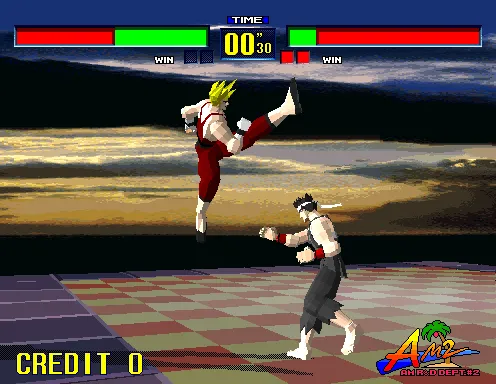


Virtua Fighter was released in 1993 on Arcades all over the world by SEGA, which was one of the lead innovators in powerful hardware for games back in that decade, as their Model 1 board had previously powered the Formula-1 inspired Virtua Racing, but what started as an experiment with human models and animations is what eventually ended up as the development of a 3D fighting game, something absolutely new at the time. Boasting an intro animation showcasing character moves, and the character select showing your 8 fighters with the portrait of your selected fighter changing also showed you a taste of graphical powerhouse and facial expressions.
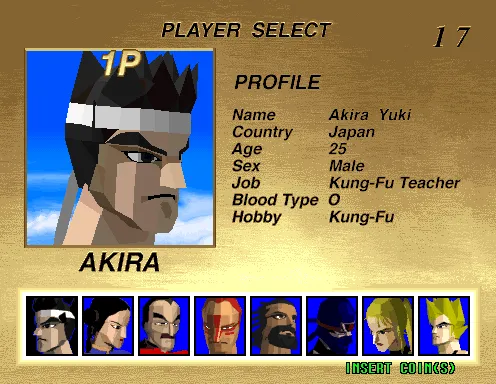
The controls are simple (Punch, Kick, Guard) but with a set amount of commands that you can use per character to unleash their unique tools, and while your options are quite limited here as well, this was a pretty good foundation to build on through sequels, and the core of the rest of the franchise was present with having to efficiently move and approach your enemy to attack, or else being guarded or countered. Also, just like most early 3D fighting games, there's no sidestep options at all, and just like Tekken's first two games, jumps are super floaty here as well.
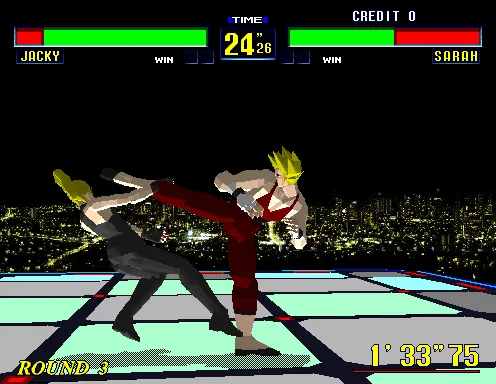
With the idea of a 3D fighting game, while Tekken went for a endlessly scrolling area (and other games used walls, including future VF and Tekken installments), Virtua Fighter actually attempted something that would only make a lot of sense in a 3D game: Ring Outs. Get the enemy close enough to the border, then avoiding them to push them out (or just be aggressive enough to push them to the edge) and you've won the round without having to deplete your enemy's health.
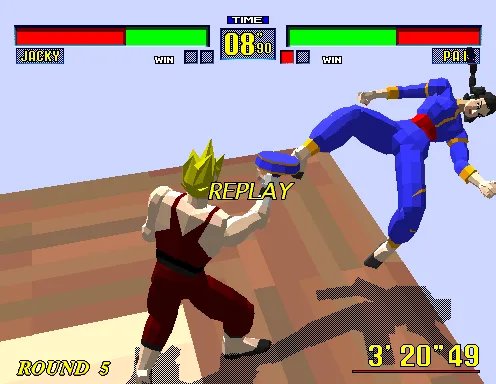
With only 30 seconds per round by default, small but damaging combos and Ring Outs, fights rely less about getting to juggle your opponent for the largest amount of time or chucking fireballs for distance, but instead knowing the range of your attacks, approaching effectively, and punish any openings...which is probably the experience you'd have with another seasoned player. Playing solo however, while knowing your stuff is useful, getting to catch the AI off-guard at the last 5 fights is annoying, being able to block many of your attacks and instantly counter-attack, or simply staying out of the way until you time out.
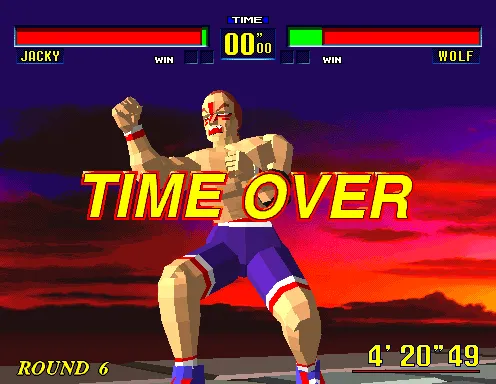
With that said, I ended up getting through some of the fights where I got stuck the most through either back-dashing to the edge and jumping over them to them try push them off the edge instead, or what I did with Akira, crouch and kick to then guard the guaranteed counter-attack...and keep crouch kicking until time runs out and he's lower in health. Unfortunately neither trick didn't work with the bonus boss Dural (which is actually made of metal; it does metal sounds when being hit) as she didn't give many chances to do enough damage for a lead, and the arena is way bigger than usual.
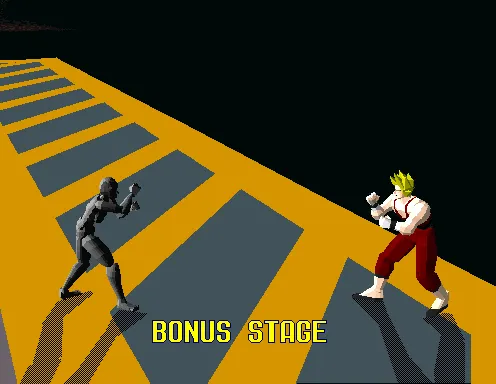
Virtua Fighter nowadays is a very simple game on the surface, but both the complexity when playing against another player as well as the historic significance for graphics and games that this game has is undeniable. On the note of complexity, the Model 1 board is actually so infamously complex that, even today, the game is not 100% perfectly playable in MAME (which is what I used for the screenshots here) as some attack will simply fail to work due to collision issues, so if you want to try this game out properly, you can try the Saturn/PC port (whichever you can get working) or emulating the VF Remix version in MAME, which while uses different graphics, it still should be VF1 at its core.
In any case, thank you for reading! If you'd like to see me cover more Virtua Fighter games, then let me know in the comments!
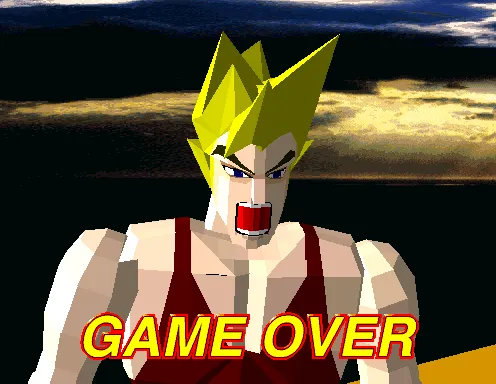

Spanish translation with DeepL. All screenshots were captured by myself.
Español

Virtua Fighter salió en 1993 en los salones recreativos de todo el mundo de la mano de SEGA, que fue uno de los principales innovadores en cuanto a hardware potente para juegos en esa década, ya que su placa Model 1 había impulsado previamente el Virtua Racing, inspirado en la Fórmula 1, pero lo que empezó como un experimento con modelos humanos y animaciones es lo que finalmente acabó siendo el desarrollo de un juego de lucha en 3D, algo absolutamente novedoso en aquella época. Con una animación de introducción que mostraba los movimientos de los personajes, y la selección de personajes que mostraba a tus 8 luchadores con el retrato de tu luchador seleccionado que cambiaba también te mostraba una muestra de potencia gráfica y expresiones faciales.

Los controles son sencillos (puñetazo, patada, guardia), pero con una cantidad determinada de comandos que puedes utilizar por personaje para dar rienda suelta a sus herramientas únicas, y aunque tus opciones son bastante limitadas aquí también, esta fue una base bastante buena para construir a través de secuelas, y el núcleo del resto de la franquicia estaba presente con tener que moverse de manera eficiente y acercarse a su enemigo para atacar, o de lo contrario ser protegido o contrarrestado. Además, al igual que en la mayoría de los primeros juegos de lucha en 3D, no hay ninguna opción para esquivar y, al igual que en los dos primeros juegos de Tekken, los saltos también son superfluos.

Con la idea de un juego de lucha en 3D, mientras que Tekken optó por una zona de desplazamiento infinito (y otros juegos utilizaron paredes, incluidas las futuras entregas de VF y Tekken), Virtua Fighter intentó algo que sólo tendría mucho sentido en un juego en 3D: Los Ring Outs. Si consigues que el enemigo se acerque lo suficiente al borde, entonces lo evitas para empujarlo hacia fuera (o simplemente eres lo suficientemente agresivo para empujarlo hacia el borde) y habrás ganado la ronda sin tener que agotar la salud de tu enemigo.

Con sólo 30 segundos por ronda por defecto, combos pequeños pero dañinos y Ring Outs, las peleas se basan menos en conseguir hacer malabares con tu oponente durante la mayor cantidad de tiempo o lanzar bolas de fuego para ganar distancia, sino en conocer el alcance de tus ataques, acercarte de forma efectiva y castigar cualquier apertura... que es probablemente la experiencia que tendrías con otro jugador experimentado. Sin embargo, jugando en solitario, mientras que conocer tus cosas es útil, conseguir pillar a la IA con la guardia baja en los últimos 5 combates es molesto, pudiendo bloquear muchos de tus ataques y contraatacar al instante, o simplemente quedándote fuera del camino hasta que se te acabe el tiempo.

Dicho esto, acabé superando algunos de los combates en los que me quedé atascado más a menudo, ya sea corriendo hacia atrás y saltando por encima de ellos para intentar empujarlos fuera del borde, o lo que hice con Akira, agacharme y dar una patada para proteger el contraataque garantizado... y seguir agachado dando patadas hasta que se acabe el tiempo y tenga menos salud. Por desgracia, ninguno de los dos trucos funcionó con el jefe de bonificación Dural (que en realidad está hecho de metal; hace sonidos metálicos al ser golpeado), ya que no dio muchas oportunidades de hacer suficiente daño para una ventaja, y la arena es mucho más grande de lo habitual.

Virtua Fighter hoy en día es un juego muy sencillo en apariencia, pero tanto la complejidad a la hora de jugar contra otro jugador como la importancia histórica para los gráficos y los juegos que tiene este juego es innegable. En cuanto a la complejidad, el tablero del Modelo 1 es tan infame que, incluso hoy en día, el juego no es 100% perfectamente jugable en MAME (que es lo que he utilizado para las capturas de pantalla aquí), ya que algunos ataques simplemente no funcionarán debido a problemas de colisión, así que si quieres probar este juego correctamente, puedes probar el puerto de Saturn/PC (cualquiera que puedas hacer funcionar) o emular la versión VF Remix en MAME, que aunque utiliza gráficos diferentes, sigue siendo VF1 en su esencia.
En cualquier caso, ¡gracias por leer! Si quieres que hable de más juegos de Virtua Fighter, dímelo en los comentarios.


Traducción al español hecha con DeepL. Todas las fotos capturadas por mí.